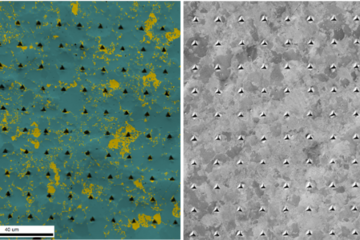All genres
801.
Journal Article
Wetting gradient induced separation of emulsions: A combined experimental and lattice Boltzmann computer simulation study. Physics of Fluids 20, pp. 072104-1 - 072104-14 (2008)
802.
Journal Article
Texture Evolution During Bending of a Single Crystal Copper Nanowire Studied by EBSD and Crystal Plasticity Finite Element Simulations. Advanced Engineering Materials 10 (8), pp. 737 - 741 (2008)
803.
Journal Article
On the origin of deformation-induced rotation patterns below nanoindents. Acta Materialia 56 (1), pp. 31 - 42 (2008)
804.
Journal Article
Three-dimensional orientation microscopy in a focused ion beam-scanning electron microscope: A new dimension of microstructure characterization. Metallurgical and Materials Transactions A 39A (2), pp. 374 - 389 (2008)
805.
Journal Article
Investigation of Three-Dimensional Aspects of Grain-Scale Plastic Surface Deformation of an Aluminum Oligocrystal. International Journal of Plasticity 24, pp. 2278 - 2297 (2008)
806.
Journal Article
The composition of the exoskeleton of two crustacea: The American lobster Homarus americanus and the edible crab Cancer pagurus. Thermochimica Acta 463 (1-2), pp. 65 - 68 (2007)
807.
Journal Article
Influence of fiber orientation on global mechanical behavior and mesoscale strain localization in a short glass-fiber-reinforced epoxy polymer composite during tensile deformation investigated using digital image correlation. Composites Science and Technology 67 (11-12), pp. 2417 - 2427 (2007)
808.
Journal Article
Effects of initial orientation, sample geometry and friction on anisotropy and crystallographic orientation changes in single crystal microcompression deformation: A crystal plasticity finite element study. Acta Materialia 55 (13), pp. 4567 - 4583 (2007)
809.
Journal Article
Theory-guided bottom-up design of β-titanium alloys as biomaterials based on first principles calculations: Theory and experiments. Acta Materialia 55 (13), pp. 4475 - 4487 (2007)
810.
Journal Article
A microstructural investigation of adiabatic shear bands in an interstitial free steel. Materials Science and Engineering A 457 (1-2), pp. 205 - 218 (2007)
811.
Journal Article
The exoskeleton of the lobster Homarus americanus as an example of a smart anisotropic biological material. Acta Biomaterialia 3 (3), pp. 301 - 309 (2007)
812.
Journal Article
The influence of sterilization processes on the micromechanical properties of carbon fiber reinforced PEEK composites for bone-implant applications. Acta Biomaterialia 3 (2), pp. 209 - 220 (2007)
813.
Journal Article
Design of high-strength steels by microalloying and thermomechanical treatment. Special Issue Materials Science and Engineering A 463, pp. 138 - 146 (2007)
814.
Journal Article
Orientation microscopy on nanostructured electrodeposited NiCo-Films. Advanced Materials Research 15-17, pp. 953 - 958 (2007)
815.
Journal Article
Retention of the Goss orientation between microbands during cold rolling of an Fe3%Si single crystal. Acta Materialia 55, pp. 2519 - 2530 (2007)
816.
Journal Article
A Finite Element approach with patch projection for strain gradient plasticity formulations. International Journal of Plasticity 23, pp. 690 - 710 (2007)
817.
Journal Article
Relative Importance of Nucleation vs. Growth for Recrystallisation in Particle-containing Fe3Al Alloys. Materials Science Forum 550, not specified, pp. 345 - 350 (2007)
818.
Journal Article
The small-angle and wide-angle X-ray scattering set-up at beamline BL9 of DELTA. Journal of Syncroton Radiation 14, pp. 244 - 251 (2007)
819.
Journal Article
A dislocation density based constitutive law for BCC materials in crystal plasticity FEM. Computational Materials Science 39, pp. 91 - 95 (2007)
820.
Journal Article
A texture-component Avrami model for predicting recrystallization textures, kinetics and grain size. Modelling and Simulation in Materials Science and Engineering 15, pp. 39 - 63 (2007)











